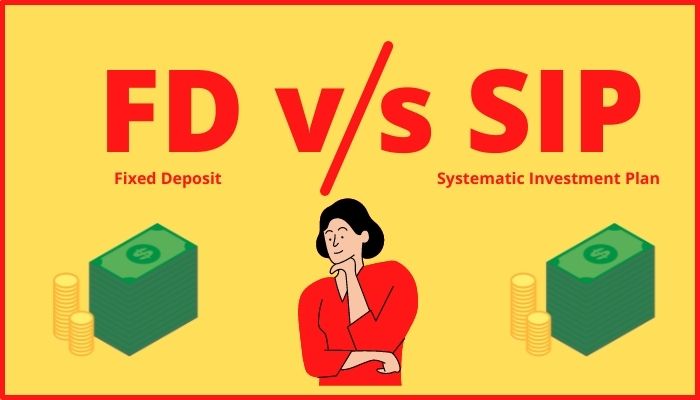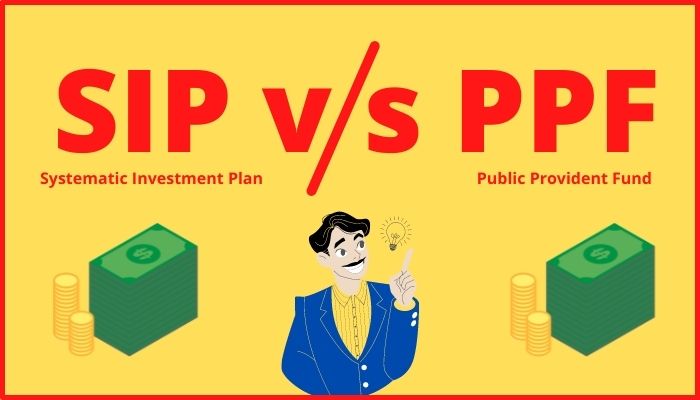SIP and PFF are two different types of Investment tools. However, people mostly look for opinions on which one is best? To know SIP vs PPF, You must first understand what they are? Let’s discuss SIP and PPF in detail with benefits, differences and comparison between these two.
Table of Contents
What is SIP?
The Full form of SIP is Systematic Investment Plan. It’s a type of mutual fund investment strategy. SIP allows you to invest a certain amount of money in a mutual fund per month.
The monthly investment method balances out your buying price and safeguards you from accidentally investing during a market top. When the cost of a mutual fund decreases, a SIP offers you extra units.
Advantages
- Customers who are unable to make a one-time lump sum contribution will find this option to be ideal and cost-effective.
- It assists in the formation of a practice of frequent saving.
- Starting with a monthly investment of INR 500 is a good place to start.
- To start with, they are basic and uncomplicated. Every mutual fund house can provide you with a complimentary SIP account.
- Allows you to take advantage of the rupee cost averaging opportunity.

What is PPF?
The full form of PPF is Public Provident Fund. It is a standard savings system established by the Indian government in 1968 under the Public Provident Fund Act. The goal of this investment is to allow consumers to accumulate money at a reasonable rate of return over time.
A PPF account can be opened at the post office or at most mainstream banks. The PPF interest rate for the first quarter of FY 2021-22 (April-June) has been set at 7.1 percent.
Advantages

- The best form of investment because it guarantees a fixed rate of return.
- Following the 15-year period, the full amount, including interest, is tax-free.
- The ability to invest in 12 equal instalments or in one lump payment over the course of a year.
- After 15 years, you have the option of maintaining your PPF account for another 5 years.
SIP Vs PPF
There are the major difference between SIP and PPF:
| Basis | SIP | PFF |
|---|---|---|
| Category | A SIP is a method of investing in a mutual fund in which a modest amount is invested on a constant schedule rather than all at once. The money is used to buy mutual fund units at their current Net Asset Value. The maximum investment amount is unlimited. | The highest limit you can invest in a single financial year is INR 150,000/-. This investment can be made in one single sum or in 12 monthly Installments. |
| Returns | Although SIPs invest in mutual funds, their returns are also determined by the mutual funds’ profitability as measured by actual market returns. | The profits are determined on a year-to-year basis. The rate of return, as well as the payments, are set at the time of account activation. The government decides the rate of interest. |
| Goal | SIP mutual fund investments are excellent for all brief, medium, and long-term objectives. They are good for accumulating wealth and achieving objectives. | Only long-term investments of 15 years or more are acceptable for a PPF. As a result, it’s a fantastic choice for retirement income, funding your children’s schooling, or preparing their wedding. |
| Other advantages | Short-term and long-term capital gains taxes apply to SIP investments in mutual funds. However, under Section 80C of the Income Tax Act of 1961, an investment in an Equity Linked Savings Scheme can permit you to seek deductions on deposited amounts up to INR 150,000. | All returns and interest earned under a PPF plan are tax exempt if it comes into the Exempt, Exempt, Exempt (EEE) definitions, and there is a tax deduction on deposited amounts up to INR 150,000 according to Sec 80C of the Income Tax Act, 1961. |
| Investment Tenure | Under a SIP, you can invest for any length of time you like. It might be as short as 6 months or as long as 1|5|10|15|20 years and more. | The lowest investment term in a PPF is 15 years, and you can extend your investment for another 5 years after it matures. |
| Lock-in Period | There is no lock-in period for SIP mutual fund investments. Only ELSS is subject to a three-year lock-in term. | A PPF has a 15-year lock-in term. |
| Flexibility | When it comes to withdrawing from a plan, a SIP gives 100% liquidity. Within three business days, the complete mutual fund amount will be credited to your associated bank account. | Because it is a long-term investment, you can only make a partial withdrawal after the 6th year from the policy’s start date. |
| Risk | Mutual funds contain a significant amount of risk because they are vulnerable to market-linked returns. The high rate of return offered by a mutual fund compensates for this. | A PPF is a very safe sort of investment that pays out fixed returns every year. The government is totally responsible for the risk. |
| Investment Amount | Minimum Investment amount is INR 500 but no maximum amount. | Minimum Investment amount is INR 500 but maximum amount INR 150,000. |
| Regulator | Government of India | Securities and Exchange Board of India |
Comparison Between ppf vs sip
After SIP vs PFF, let’s think about ppf or sip:
-
Security
The Public Provident Fund (PPF) is a government-backed financial tool. The money put in PPF is used by the state, and the government also pays interest on it. As a result, there is practically little risk of default.
Mutual fund money, on the other side, is vulnerable to market fluctuations. Owing to changes in the prices of the companies maintained by the fund the worth of equity funds swings virtually every day. Due to variations in bond prices, the value of debt funds fluctuates as well.
Mutual funds, on the other hand, have a longer-term growth potential. Investors pay a price for accessing long-term growth opportunities in the form of uncertainty.

-
Return
The government sets and guarantees the returns on PPF. Each quarter, the exact rate is determined. In the past, rates have fluctuated approximately 8% per year. Here’s a look at how PPF rates have changed over time. :
| Time Period | Interest Rates in Percentage |
| January to March 2021 | 7.1% |
| October to December 2020 | 7.1% |
| July to September 2020 | 7.1% |
| April to June 2020 | 7.1% |
| January to March 2020 | 7.90% |
| October to December 2019 | 7.90% |
| July to September 2019 | 7.90% |
| April to June 2019 | 8.0% |
| January to March 2019 | 8.0% |
| October to December 2018 | 7.8% |
| July to September 2018 | 7.8% |
| April to June 2018 | 7.9% |
(Source: National Savings Institute)
Mutual fund returns, on the other side, are market-linked. It depends largely on market circumstances and the fund manager’s effectiveness. The performance of a handful of India’s largest mutual funds is listed below. The returns are determined during a five-year period, beginning May 1, 2014, and ending May 1, 2019.
| Fund | SIP Return |
| Aditya Birla Sun Life Frontline Equity | 9.60% |
| Kotak Standard Multicap Fund | 13.29% |
| HDFC Top 100 Fund | 11.73% |
| ICICI Balanced Advantage Fund | 10.22% |
| SBI Small Cap Fund | 15.83% |
(Source: Value Research, All plans are Direct Plans)
-
Liquidity
PPF deposits have a 15-year lock-in term. Your open-ended mutual fund investment, on the other hand, can be liquidated on any trading day. Mutual funds are far more liquid than PPF deposits due to the option of redeeming your funds as needed.
PPF deposits can be used to take out a loan, but only from the third to the sixth year after the account is opened. After the conclusion of the 6th financial year,
Example
The start of the 7th financial period from the year of account opening, you can request a partial PPF withdrawal. Nevertheless, it is recommended that one consult the bank’s website to see whether partial withdrawals are permitted.
Withdrawals are permitted after 5 years in some banks, including ICICI and Axis, and after 7 years in others (SBI and HDFC).
-
Taxes
Under Section 80C of the Income Tax Act, 1961, you can invest up to Rs 1.5 lakh in a PPF account and get a tax deduction of up to Rs 1.5 lakh per year.
PPF interest is likewise tax-free, although it must be reported on the annual income tax return. The amount invested in a PPF at maturity is likewise tax-free.
To put it another way, PPF is tax-free, exempt, exempt. Mutual fund returns are taxed differently depending on the kind of mutual fund scheme and the length of time invested.
Mutual funds taxation
Under Section 80C, you can earn a tax deduction of up to Rs 1.5 lakh per year if you invest in a certain type of mutual funds known as ELSS funds. Nevertheless, this is not applicable to other types of mutual funds.
Taxation Chart of Mutual funds
| Category of Scheme | Items | Short-Term Capital Gains Taxation | Long-Term Capital Gains Taxation |
| Equity-based schemes | Holding Time | Below One Year | More than One Year |
| Tax rate in % | 15% | 10%* | |
| Non-equity based schemes | Holding time | Below Three Year | More than Three Year |
| Tax rate in % | Income Tax Slab Rate of Investor | 20% after indexation |
(Source:Income tax Department)
Conclusion – Sip or ppf which is better
While it is impossible to compare a market-linked instrument to a fixed-income instrument, PPF is advised for those who are completely risk averse. SIP investments, on the other hand, are recommended for those who want high returns with some market volatility.
This is all from our side regarding SIP vs PPF. Although, if you have any doubts about ppf vs sip you can just comment below.
Other Interesting blogs related to SIP vs PPF:
SIP Investment is Good or Bad?
How to Invest in Mutual Funds without Demat Account
FAQ About ppf sip
SIP vs PPF in hindi
एसआईपी एक प्रकार की म्यूचुअल फंड निवेश रणनीति है। एसआईपी आपको हर महीने एक म्यूचुअल फंड में एक निश्चित पैसा निवेश करने की अनुमति देता है। पीपीएफ भारत सरकार द्वारा 1968 में पब्लिक प्रोविडेंट फंड एक्ट के तहत स्थापित एक मानक बचत प्रणाली है।
ppf alternative
The best alternative of PPF is FD or SIP in Mutual funds.
What is SIP in mutual fund?
SIP a type of mutual fund investment strategy. SIP allows you to invest a certain amount of money in a mutual fund per month.
Full form of SIP
Full form of SIP is Systematic Investment Plan.
Full form of PPF
Full form of PPF is Public Provident Fund.

